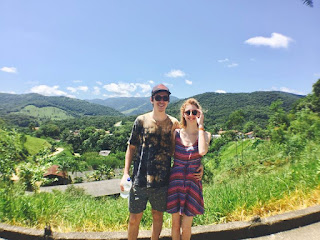Bioluminescent Mushroom Volunteer and Blue Larva Discovery
With my time coming quickly to an end at IPBio, there are so many things I will miss about this place. For one, the constant nature. Just outside the door there is forest abound, full of birds of all kinds, mushrooms and some really strange sounding frogs. The diversity of life here is truly mind-boggling. I feel like I see a new type of plant or insect everyday. I would appreciate the latter kept its diversity out of the house however. I will also sorely miss the constant smiles and friendliness of the people here. After growing up in the west coast of the US where people for the most part keep to themselves, the friendly greetings from nearly everyone I pass on the street took some getting used to. People are also surprisingly patient while I struggle to conjure up some Portuguesish sounding sentences. All that time spent on duolingo sure came in handy…
I came to the Reserve to work on the bioluminescent mushroom program. How did I get here? I still ask myself that– I never would have imagined being where I am right now. I went to university for ecology and
other environmental sciences, but mycology has been a hobby of mine for a number of years. When I saw the volunteer position, it was something I had do; I mean, glowing mushrooms in a Brazilian rainforest? To give a little background, of the 86 described species of luminescent mushrooms, Brazil is home to nearly 20, with 16 of these just from the southern states of Sao Paulo and Parana. The mushroom program at the Betary reserve aims to grow these mushrooms in controlled conditions so that anyone that visits the reserve can see the magnificence of their luminescence since the mushrooms are only prevalent in the humid summer months. Some days I spend in the lab doing various tests, other days I am doing research and planning for the next project or, when we need to isolate one of the mushrooms or want to look for new species, we go into the forest at night to search. This involves turning off the flashlight and slowly walking while looking around you. It’s really a unique and surreal experience. There are some places in the forest where if you stop and look around, you can see dozens of points of light on the ground- mycelium inside fallen leaves that make them seem as if they are glowing. Since there has been relatively little research on mushrooms in Brazil, there is so much still to be discovered. Since January, seven potentially new species of mushrooms have been discovered on the reserve, which begs the question, how many luminescent species are there really in Brazil?
Opportunities for trips in the area are pretty endless. From the multitude of caves to explore in PETAR, the surreal landscape that is Iguacu Falls, to island paradises filled with dolphins (for an excellent description of Cananeia, one such place, see Matt’s previous post). Tess, another volunteer here right now, and I decided that rather than sit in a stuffy Policia Federal office, we would do a border run to renew our visas so we could stay for a total of 6 months. And what better place to do this than Iguacu falls on the border of Argentina. While the guy at the border still had the endearing mix of impatience and displeasure you expect from border officers, it was definitely better than what would have awaited us at the local office if it is anything like the internet seems to indicate. The falls themselves are extremely impressive. Numbering over 200, and falling from heights as high as 82 meters, it looks like something straight out of a movie.
Written by: Grant Johnson, Bioluminescent Mushroom Volunteer from USA






Wow, the work Grant is doing is so amazing. I can't wait for his first book to be published.
ReplyDelete